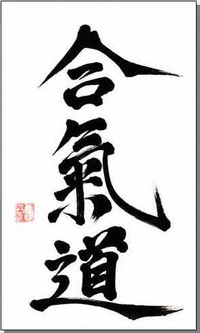PAF
- Category: Aikido
What is Aikido
 Aikido is a Japanese martial Art that stresses self defense by harmonizing with an attack and controlling the attacker by joint locks or their own momentum. Aikido was founded by Morihei Ueshiba in the mid 1930's. He is known as O'Sensei, or great teacher. He had mastered several martial arts in his youth and had a very strong spiritual side as well. O'Sensei had a realization that his martial art was not about fighting and winning, but that it was about love and harmony. Thus, Aikido was born.
Aikido is a Japanese martial Art that stresses self defense by harmonizing with an attack and controlling the attacker by joint locks or their own momentum. Aikido was founded by Morihei Ueshiba in the mid 1930's. He is known as O'Sensei, or great teacher. He had mastered several martial arts in his youth and had a very strong spiritual side as well. O'Sensei had a realization that his martial art was not about fighting and winning, but that it was about love and harmony. Thus, Aikido was born.
The three characters (or kanji) representing aikido are translated as follows:
Ai - Means harmony
Ki - Means energy or spirit, either your own, or the world's collective energy
Do - Means the way or the approach to training that includes learning the physical movements as well as developing your whole self.
Thus, Aikido can be defined as the way of learning to harmonize with the environment we live in. In the self defense context it means not fighting with an opponent or resisting an attack. This is what sets Aikido apart from other martial arts and self defense systems. The concept of accepting an attack and dealing with it without fighting is unique. It also is counter to our very basic "fight or flight" response. Thus, a large part of deeper Aikido training is to learn to be calm and relaxed and to be aware and alert to what is happening around you. The other aspect of training is to learn the basic physical techniques and movements to respond to any kind of attack.
This combined approach develops your entire being, not just your physical side. Aikido is effective for self defense, but more importantly we learn how to deal with the stresses and pressures of daily life. Being relaxed and calm minimizes the tension, conflicts and anger that occur every day of our lives.
- Category: Aikido
Welcome Students
Most new students are interested in Aikido for a specific reason. This reason could be self defense or better health or because your friends are doing it or any number of other things. However, learning Aikido is a journey, not a destination.
There is an old saying: "A journey of a thousand miles begins with the first step."
Your first step is to get on the mat for your first class. How do you choose a dojo (an Aikido school)? The best way is to observe a class.
Welcome to the Pacific Aikido Federation.
There are a number of things that happen before a journey starts. As a new student you naturally will have questions and concerns.
What is Aikido?
How does a new student fit in?
What do people wear?
How do I join a Dojo?
Welcome to your first step of a long and rewarding journey.
- Category: Aikido
Japanese Terms used in Daily Practice
The following terms are commonly used in Aikido training, and in the standard techniques tested during Aikikai examinations for a higher rank.
The names of Aikido techniques (waza) consist of two parts:
- First half, the name of the attack
- Second half, the name of the throw
Examples: mune tsuki + ikkyo, katate tori + shiho nage, shomen uchi + irimi nage.
Thus the first two parts of the table are Attacks and Throws. Any attack combines with any throw to become a waza: For example, a partner can attack with mune tsuki and be thrown with ikkyo, shiho nage, kote gaeshi, irimi nage or one of many kokyu nage.
- Category: Aikido
Vocabulary
What is a Dojo?
The word Dojo means "training hall". For example, the Aikido Center in Mountain View is a spacious facility, with a padded training mat, separate dressing rooms and bathrooms, and a small office.
What does Sensei mean?
Sensei is an honorific title meaning "teacher". The head of a dojo is always referred to as Sensei, and other instructors as well. O-Sensei means great teacher. In Aikido this refers to Ueshiba Sensei, the Founder of Aikido.
Site support - Ivan Korolevskiy
